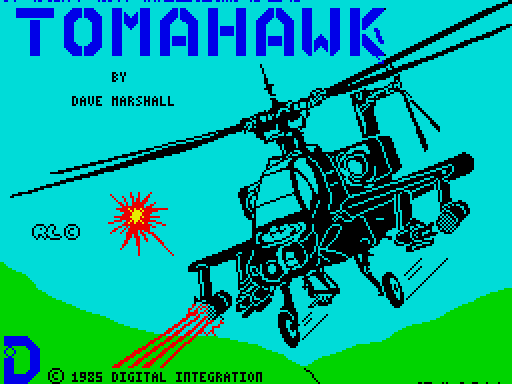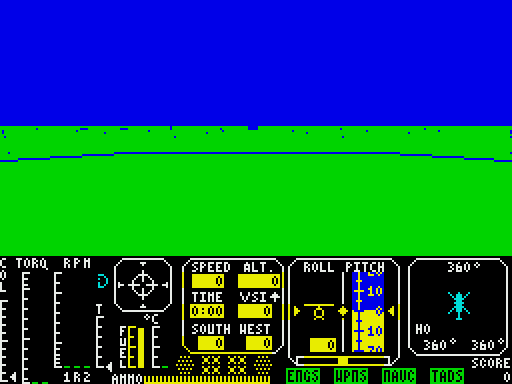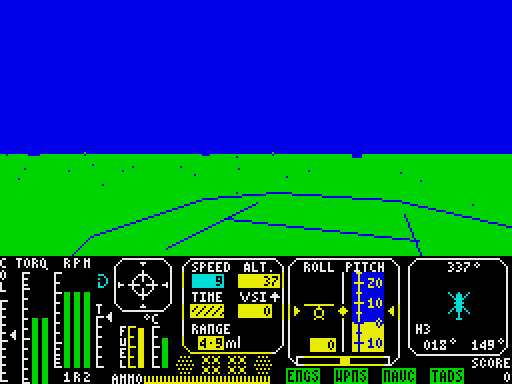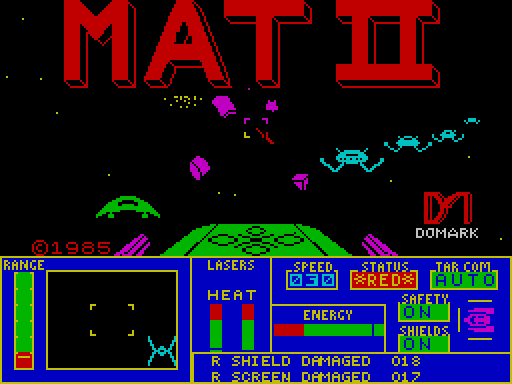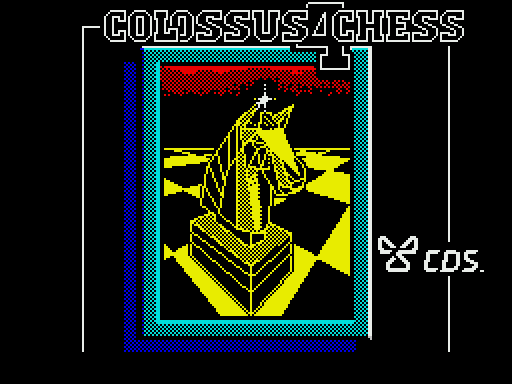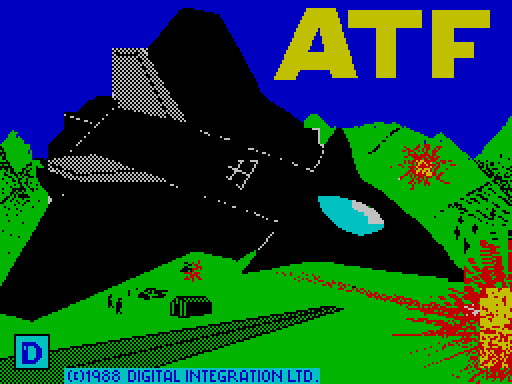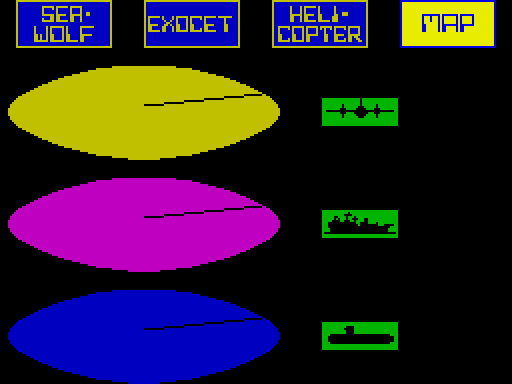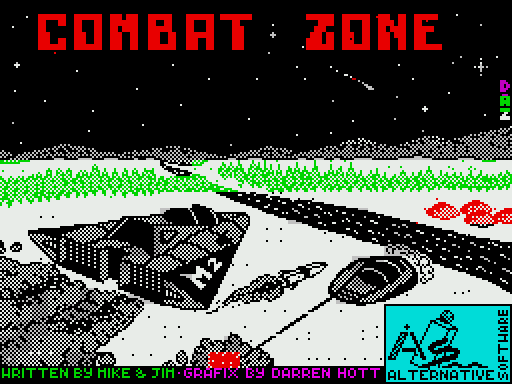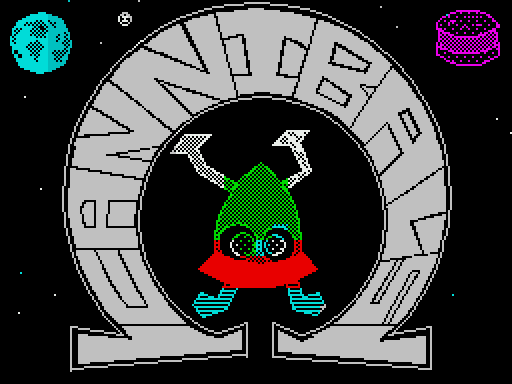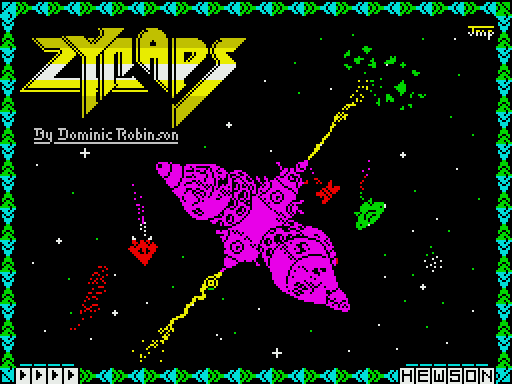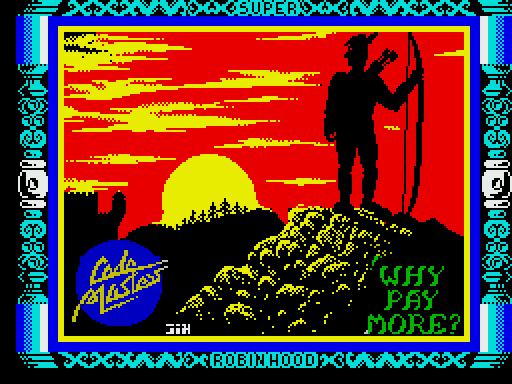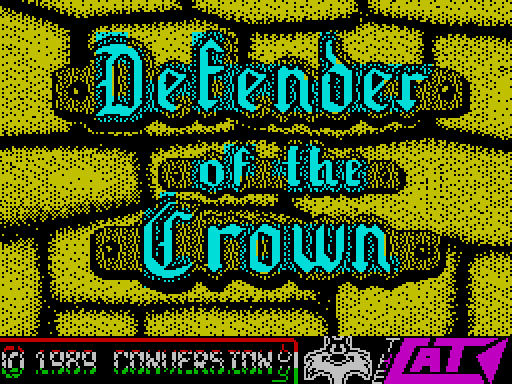Tomahawk
Описание игры
Удивительно, но даже в далеком 1985 году на домашнем компьютере ZX Spectrum с 48 килобайтами памяти на борту, существовали удивительно подробные симуляторы самолетов и вертолетов. Несмотря на «проволочную» графику, они давали возможность игроку почувствовать себя сидящим внутри настоящей боевой машины, управлять ею и участвовать в вооруженных конфликтах.
Вот и в игре Tomahawk вам предстоит почувствовать себя пилотом великолепного вертолета американских ВВС Apache, волею командования заброшенного куда-то в дебри Ирака. Сидя в кабине, перемещаясь над полем боя, расположенном где-то в пустыне, вам предстоит уничтожать вражеские танки и наземные установки.
Приборная панель включает в себя такие приборы, как (слева направо): указатель положения рычага отбора мощности, указатели положения газа первого и второго двигателя, указатель скорости вращения двигателей и лопастей несущего винта, рамка целеуказателя, указатель уровня топлива и температуры двигателя, консоль датчиков пилота, искусственный горизонт, дисплей радара, а также указатели проблем с двигателем, оружием, навигацией.
Управление вертолетом
- 5/6/7/8 – управление автоматом-перекосом для создания соответствующих углов крена и тангажа
- caps shift/z – правый и левый рычаг газа
- C – изменение режима работы радара
- N – следующая цель
- P – выбор оружия
- 0 – огонь
- Q/A – перемещение рычага отбора мощности
- W/S – перемешения рычага газа
- M – карта
- H – пауза
- J – продолжить игру
- caps shift и пробел одновременно – прервать миссию.
Видео c игрой
Описание игры на другом языке
TOMAHAWK(tm)
TOMAHAWK is a real-time flight simulation based upon the
U.S. Army AH-64A APACHE Advanced Attack Helicopter -- the
meanest, deadliest combat helicopter ever to rule the skies!
Its specialised job is to hunt tanks and destroy anything
that gets in its way. The Apache was built specifically to
fight and survive, night and day, in the thick of the
battlefield. Flying a real helicopter is a demanding task
requiring training and practice -- particularly ground
attack. TOMAHAWK gives you this challenge. Climb into your
cockpit and prepare for take-off......
Features of TOMAHAWK:
* Spectacular 3D real world display
* Fully aerobatic (within limitations of real helicopter)
* Ground attack and air-to-air interception
* Over 7000 ground features
* Day/night vision systems
* Cloudy conditions, crosswinds & turbulence
* Doppler navigation and target tracking system
* Laser guided missiles, plus rockets and 30mm chain gun
* Selection of training and combat missions
* Impressive sound effects
* Pilot ratings -- Trainee to Ace
* Twin joystick option
LOAD ""
Follow LENSLOCK procedure for security code entry.
3D real-world display:
Features include landing pads, buildings, trees,
transmission pylons, mountains, enemy tanks, field guns and
helicopters. Ground texture is visible when flying below
500 feet to enhance the sensation of speed. It is possible,
with practice, to fly between trees and mountain peaks.
MENU OPTIONS
MISSION 1 -- FLYING TRAINING -- used for helicopter
familiarisation & developing ground attack skills. Enemy
ground forces will not return fire.
MISSION 2 -- COMBAT -- a short mission to destroy invading
ground forces and return to base.
MISSION 3 -- COMBAT -- Surrounded totally by enemy territory,
your task is to liberate the entire map from enemy
occupation. Each hostile sector becomes allied when enemy
forces destroyed.
MISSION 4 -- COMBAT -- A strategic battle for occupation of
the entire map. your task is to support allied ground
forces in their battle along the front line.
2. DAY OR NIGHT -- Daytime: blue or overcast sky, green
ground Nighttime: no horizon, computer-enhanced infra-red
imaging. (Pilots' Night Vision System.)
3. CLEAR OR CLOUDY -- option for overcast sky with
selectable cloudbase for instrument flying.
4. CLOUDBASE -- selectable from 50 ft to 1000 ft.
5. CROSSWINDS & TURBULENCE -- for the experienced pilot!
Variable crosswind & turbulence effects.
6. SOUND -- selectable ON or OFF.
7. PILOT RATING -- TRAINEE
SQUADRON
INSTRUCTOR
ACE
The pilot rating is equivalent to difficulty level and
varies potency of enemy. With each increase in pilot
rating, the enemy's accuracy doubles!
8. CONTROLS -- keyboard or joystick options.
INSTRUMENT PANEL LAYOUT
Bar scales, from left:
Collective level position indicator -- COL
Engine Torque -- TORQ 0 to 130%
(power demanded from engines)
Turbine & Rotor RPM -- 0 to 120%
Throttle position indicator -- T
Fuel
Engine temperature
WEAPONS:
AMMO -- 1200 rounds 30mm ammunition, 750 rounds/min, 38
unguided rockets (19 each side), 8 Hellfire missiles -- laser
guided, auto-tracking
Failure status lights: engines, weapons, nav. computer, TADS
INSTRUMENTS: (left to right)
TADS
Target Acquisition & Designation System --
(small instrument above fuel indicator). Used to identify
and track tanks, field guns and helicopters. Red = hostile,
green = friendly. Includes range readout in feet when
target is less than 10,000 feet away.
VDU -- Visual Display Unit
Speed, in knots (yellow = forwards, cyan = backwards)
Altitude, feet
VSI -- Vertical Speed, ft/sec (arrow UP = climb, arrow DOWN = descent)
TIME -- Time to reach target, in hours and minutes (hashed if
greater than 4 hrs, zero if less than 1 minute)
Ground position -- autoranging navigation computer
Within 0.1 mls: resolution in feet
Within 4.9 mls: resolution in 0.1 mls
Over 5 mls: resolution 1 mile
ARTIFICIAL HORIZON
Roll symbol & roll angle readout
Pitch indicator -- nose up/down attitude
Sideslip indicator -- sideways "drift"
DOPPLER NAVIGATION/COMPASS -- (rightmost instrument)
Readout of Heading, Bearing & Track.
Heading: direction in which the helicopter is pointing.
Track: flight path direction.
Bearing: heading required to point at objective.
Note: a helicopter can be pointing in one direction
(Heading) but moving in a different direction (Track) e.g.
sideways! Match the heading to the target bearing to
intercept target. The flashing cross indicates relative
bearing of target.
Four modes:
B: Beacon navigation (8 beacons)
H: Landing Pad (4 pads per sector)
T: Ground target tracking (8 targets per sector)
Lightning symbol: enemy helicopter interception
Flashing symbol warns of approaching enemy helicopter.
CONTROLS
THROTTLE -- key W to open throttle
key S to close throttle
Controls engine/turbine rpm. Normally set to fully open
unless practising engine-off landings. Assisted in flight
by computerised autothrottle control.
COLLECTIVE LEVER -- key Q increases lift
key A decreases lift
This is basically a vertical lift control used for take-off
to the hover, and forward thrust control in straight and
level flight.
CYCLIC CONTROL
joystick forward (cursor key 7) tilts nose down
joystick back (cursor key 6) tilts nose up
joystick right (cursor key 8) to roll right
joystick left (cursor key 5) to roll left
RUDDER -- key Z to yaw right
key CAPS SHIFT to yaw left
TWIN JOYSTICK OPTION
Interface 2 (and equivalent joystick interfaces) have an
optional twin joystick mode for enhanced helicopter control:
right hand joystick = cyclic control & weapon release
left hand joystick:
forward = key A = decrease collective
back = key Q = increase collective
right = key Z = rudder right
left = CAPS SHIFT = rudder left
fire button = key N, select next objective
DOPPLER MODE
Key C selects between beacon mode (B), landing pad mode (H),
ground attack mode (T) or air-to-air mode (lightning symbol)
on DOPPLER/COMPASS instrument.
key N selects "next objective" in each mode:
8 beacons (0 to 7)
4 landing pads per sector (0 to 3)
8 enemy targets per sector (0 to 7)
1 enemy helicopter
Press CAPS SHIFT and SPACE together to abort mission and return to the menu.
WEAPON SYSTEMS AND TARGET ATTACK
When in ground attack or air-to-air mode, the weapons
systems are activated. The helicopter must be airborne to
fire its weapons. Select between gun, rockets or missiles
using key P. The gun & rockets are manual tracking only
i.e. the target must be in the sights when the weapon is
launched or for the TADS system to operate. The missile
system locks on to any hostile target passing through the
sights & lock-on is depicted by the dashed square becoming a
solid outline. Tracking is automatic if the target remains
on screen.
GUN -- diagonal sights -- range 2000 ft
ROCKET -- vert/horiz sights -- range 4000 ft
MISSILES -- square sights range 3.1 mls
Fire button = key 0 or fire button on cyclic joystick.
The time for a weapon to reach a target will depend on how
far the target is away. It it possible to locate and
destroy enemy targets in both map mode and in cloud, but the
weapon sights will not be displayed. During combat, enemy
fire is indicated by a flashing border. The whole display
will flash if your helicopter is hit and also when ground
forces destroy each other (Mission 4 only). Damage to
helicopter systems is indicated on the failure status panel
and structural damage is shown by the Doppler helicopter
symbol turning red. A third structural hit is fatal! The
chances of being hit by the enemy are decreased by swerving
during the attack. You have a total of 3 helicopters per
mission. Study the mission report for crash evaluation and
performance report.
If an enemy helicopter is approaching, a
warning symbol will be flashed on the Doppler instrument if
you are not in air-to-air combat mode. You are advised to
select air-to-air combat mode and
destroy the enemy helicopter before he gets too close!
Scoring Scheme
Weapon Target
Used Field gun Tank Helicopter
Gun 20 - 100
Rockets 10 20 50
Missiles 5 10 25
Points Scored
It is not possible to destroy a tank with the chain gun.
Destruction of allied forces will result in total loss of
score. Although it is much easier to hit a target with a
missile, fewer points will be scored. The enemy will begin
to fire back at a range of between 4000 and 5000 feet,
making it much more dangerous to use guns (range 2000 ft!)
but the points scored will be higher.
MAP
Use key M to select map or to return to normal display.
Your helicopter is shown by the flashing symbol with a tail.
Enemy helicopters are shown without a tailplane. Beacons 0
to 7 are used for navigation purposes. by selecting the MAP
mode when sitting on any allied pad, the helicopter may be
moved to another allied sector by using the cursor keys 5,
6, 7 or 8 (or joystick). This feature eliminates the need
to lengthy straight and level flight to visit each sector.
When training (Mission 1), all sectors are allied and any
landing pad may be used for refuelling, rearming or repairs.
All sectors contain enemy tanks and field guns for target
practice. In combat mission, territory is distinguished by
blue (Allied) sectors and red (Hostile sectors. A flashing
blue sector indicates the presence of enemy forces in Allied
territory. Likewise, a flashing red sector indicates the
presence of allied forces in hostile territory. You will be
capture by the enemy
if you touchdown in hostile territory. The destruction of
all enemy forces in a hostile sector will result in the
sector becoming allied. Likewise, if all allied forces in a
sector are destroyed, the sector becomes hostile. The map is
designed to wrap around at the edges i.e., when flying off
the map, the helicopter will reappear at the opposite edge.
COMPLETION OF MISSION
A mission is completed when all enemy ground forces have
been destroyed and you have returned safely to a landing
pad. After touchdown, close the throttle to bring the
turbine and rotor rpm to zero. A complimentary mission
report will follow.
PILOT'S NOTES
The controls in a real helicopter are "proportional", i.e.
their effect is proportional to the displacement from
centre. It is not possible to implement this feature on the
Spectrum joystick since it contains simple on/off
microswitches. by making the effect of each control
proportional to how long the joystick is held, a simple
approximation to "real" controls has been achieved, i.e.
momentary operation of the joystick for fine control, and
hold to build up a rapid rate. This does however mean that
the joystick must be operated repeatedly for steady turn or
to hold a pitch angle. Helicopters are naturally unstable
and difficult to fly without autostabilisation. The Apache
is fitted with Digital Automatic Stabilisation Equipment
(DASE) making it far easier to fly than most modern
helicopters.
Take-off procedure:
1 Ensure that collective indicator at minimum.
2 Select full throttle -- key W -- hold pressed until
throttle indicator at maximum.
3 Wait for turbine rpm and motor rpm to reach 100%.
4 Increase collective pitch by pressing key Q until
lift-off occurs. VSI indicates vertical speed in ft/sec.
5 Reduce collective (key A) to achieve hover i.e. VSI = 0.
The helicopter is now hovering above the helipad.
6 Turning on the spot is accomplished by applying left or
right rudder (CAPS SHIFT or key Z).
Transition to forward flight from hover
1 Increase collective (key Q) to between 80% to 100%
Torque. Reduce collective (key A) if overtorque warning
sounds.
2 Tilt nose of helicopter downwards (key 7 or joystick
forward) to between 15 and 30 degrees.
3 Speed will be seen to increase. Autostabilisers will
slowly raise the nose of the helicopter to a level attitude.
4 Reduce collective (key A) to adjust for VSI = 0 ft/sec
i.e. not climbing or descending.
The helicopter will now be cruising at a steady forward
speed. The Apache is a very agile helicopter. From a stable
hover, it can reach 100 kts in approx. 6 seconds by pulling
100% torque and tilting the nose downwards to approx. 30
deg.
Straight & Level Flight
Forward speed is related primarily to the torque setting &
hence the collective lever setting, assuming the helicopter
is not autorotating (explained later). Typical speed/torque
settings are as follows:
Torque Speed
44% 60 kts
60% 119 kts
75% 147 kts
100% 159 kts
These values will vary slightly with altitude and changes in
helicopter weight resulting from fuel consumption and weapon
release. The Apache is fitted with computer-controlled
stabilator which enable the helicopter to cruise at any
speed with the fuselage level.
Turning Flight Providing that the forward speed is greater
than 60 kts, turning is achieved by simply banking left or
right. Some vertical lift will be lost by banking and the
helicopter will begin to descend. This may be counteracted
by increasing the collective setting. The helicopter will
begin to slow down in a turn unless the pilot dives to
sacrifice height to maintain speed. At speeds under 60 kts,
the helicopter will tend to "drift" in the turn, shown by
the sideslip ball at the bottom of the artificial horizon.
Turns may be assisted by applying the rudder, but this will
reduce forward speed. Fluctuations in rotor rpm occur during
a turn because of g force effects. The autothrottle will
adjust the turbine rpm accordingly to keep the rotor rpm at
approximately 100%.
Slowing down and returning to the hover
1 Gently raise the nose of the helicopter by pulling back
on the joystick(key 6). The aircraft will begin to slow
down and also climb. Maintain the nose-up attitude by
repeatedly pulling back on the joystick (gently!).
2 Reduce the rate of climb by reducing the collective (key
A) to keep VSI to approximately zero. As the forward speed
drops below 60 kts, increase collective (key Q or 2nd
joystick back) to counteract sink rate. Allow nose of
helicopter to return to level flight as speed approaches zero.
3 Adjust collective as required to achieve a VSI of zero.
The helicopter should now be in a stable hover.
4 The helicopter will also slow down when turning, provided
that it is not in a dive. Banking repeatedly left and right
is another common method of slowing down.
5 Providing that the forward speed is less than 60 knots,
the pilot may apply rudder to increase sideslip (sideways
drift). The helicopter will slow down dramatically as a
result of the large drag forces generated.
Landing
The helicopter may be landed from the hover (vertical
descent) or at forward speeds of less than 60 kts.
(a) From hover: Lower the collective lever to maintain a
steady rate of descent. Maximum VSI at touchdown = 12 ft/s.
Ground cushion effect will be experienced below 30 ft,
resulting in reduction of descent rate.
(b) Rolling touchdown: With a forward speed of less than 60
kts, gently lower the collective lever to begin descent.
Maximum VSI at touchdown = 12 ft/s. After touchdown, the
helicopter will slow down and eventually stop. Steer on the
ground by using rudder control.
Taxiing on ground
The helicopter may be taxied on the ground, up to a maximum
speed of 60 kts, providing that the engine/rotor rpm are at
100%. Assuming that the helicopter is stationary, raise the
collective lever to produce 20% torque. Pushing forward on
the main joystick will accelerate the aircraft, and likewise
pilling back will decelerate and eventually stop. Steer by
using the rudder.
Refuelling/Rearming/Repairs
By landing or taxiing onto a helipad (not an enemy one!) the
aircraft may refuel, reload with weapons, and be repaired.
Once on the pad, close the throttle to bring turbine & rotor
rpm to zero. The helicopter will be serviced and prepared
for the next take-off immediately.
Backward & Sideways Flight
Starting from the hover, the helicopter may be flown
backwards by raising the collective lever and raising the
nose to approximately 10 deg. The peed readout will turn
blue to denote backward flight. Keep the nose of the
helicopter pitched up to sustain speed. Likewise, the
helicopter may be flown sideways by rolling left or right
and raising the collective lever. The speed readout does
not show sideways speed and the pilot must watch the
sideslip indicator on the artificial horizon in order to
monitor sideways drift.
Torque Turn
This manoeuvre allows the pilot to perform a 180 deg turn
with a dramatic climb and simultaneous turn.
With a forward speed of 100 kts or more, pull the nose of
the aircraft up to approx 70 deg pitch. Hold this nose-up
attitude until the speed drops to approx 60 kts. Release
joystick & apply rudder until heading has changed by approx
160 deg. Release rudder, adjust roll to zero if necessary
and accelerate with nose down attitude. During the
manoeuvre, the helicopter will roll, pitch & yaw
simultaneously, pulling down on a reciprocal heading.
Aerobatics
The Apache may be flown safely within the following limits
Pitch � 90 deg
Roll � 100 deg
Control response may become unpredictable outside these
limits i.e. loops & rolls are NOT recommended!
Autorotation
Autorotation is equivalent to the helicopter "gliding"
through the air and is used when the pilot wishes to descend
rapidly or after engine failure.
During autorotation, the rotor blades are being driven by
airflow through the rotor disc as the helicopter descends.
This reduces the power required from the engines and the
engine RPM is automatically reduced to maintain 100% rotor
speed and the "split" between turbine rpm and rotor rpm can
be seen on the bar scales. Autorotation is best performed
at approximately 60 kts. and above 500 ft. Entry in
autorotation is made by gently lowering the collective
lever:
(a) Engines active
As the descent rate builds up, the automatic throttle
control will be seen to reduce the turbine rpm. Any
fluctuations in rotor rpm will be compensated automatically
by the autothrottle. As the altitude falls below 200 feet,
the pilot should begin to pull the collective lever up to
reduce the rate of descent, accompanied by raising the nose
of the helicopter if he wishes to slow down. With practice,
the pilot co-ordinate increasing the collective and
adjusting the pitch angle in order to slow down to the hover
just a few feet above the ground.
(b) Engine-off landings
In the event of failure of both engines or if the pilot
deliberately closes the throttle in flight, engine rpm will
reduce to zero. The pilot must respond quickly by lowering
the collective lever before the rotor blades slow down too
much. Rotor rpm is controlled during the descent by careful
adjustment of the collective lever. Keeping the helicopter
level and the speed between 50 & 60 kts, raise the
collective lever just before touchdown to bring the rate of
descent to below 12 ft/sec.
Warnings -- limits worth noting!
1. The maximum permissible speed of the Apache is 197 kts,
in a dive. I f the speed should rise above this, the speed
readout will flash red and the pilot
will get an audible warning. If he continues to increase
his speed, the helicopter will shed a rotor blade at 210
kts, resulting in catastrophic loss of control!
2. If the pilot demands too much power from the engines
(overtorque), the torque readout will be in the red, the
engine temperature will rise into the red, and an audible
warning will occur. If this warning is ignored, the engines
will overheat and eventually fail. It is possible to hover
and fly on one engine but flying time is limited if both
engines have failed!
HELICOPTER AERODYNAMICS
The following description is intended only as an
introduction to the subject. We recommend the following
book for further reading: "The Helicopter--history, piloting
& how it flies" by John Fay, Published by David & Charles
The rotor blades of a helicopter force air downwards as they
pass through the air. This results in an upward lifting
force. The pilot may increase this force by "collectively"
increasing the "angle of attack" of all the rotor blades and
the helicopter will rise. In order to move forwards, the
rotor blades are tilted forwards, thereby using part of the
lift to accelerate the helicopter. The amount of lift
generated by the rotor blades increases with helicopter
speed. This is called translational lift and results in the
pilot requiring less collective as his speed increases.
however, as the helicopter continues to accelerate, this
extra lift is offset by the build up of large drag forces
which in turn must be overcome with higher collective
settings. This variation in "operating efficiency" can be
visualised as a curve, with its peak at approximately 60
kts. A helicopter requires much more power for a vertical
climb than it does for the same rate of climb with forward
speed. Its hovering ceiling is much lower than its ceiling
with forward speed. Both of these effects are due to
translational lift.
TECHNICAL DATA
Performance:
Maximum speed 197 kts
Maximum cruise speed 162 kts
Maximum vertical rate of climb: 1450 ft/min.
Service ceiling 20,000 ft.
Endurance: 1 hr 50 min to 2 hr 30 min, according to weapon
load and mission profile.
Engines: Two General Electric T700-GE-701 turboshaft engines
Each rated at 1695 shp
Weight: Empty: 11, 015 lb (4996 kg)
Primary mission gross weight: 14,694 lb (6665 kg)
Maximum take-off weight: 17,650 lb (8006 kg)
Armament:
One Hughes M230A1 chain gun 30 mm automatic cannon with up
to 1200 rounds, rate of fire 750 rnds/min. Four underwing
strongpoints to carry up to 16 Rockwell AGM-114A Hellfire
laser-seeking anti-armour missiles or up to 76 2.75 inch
rockets
Dimensions:
Rotor diameter 48 ft, tail rotor diameter 9 ft 2 in
Overall length 58 ft 3 in
Overall height 15 ft 3 in
Crew:
Co-pilot/gunner and pilot in tandem
History:
First flight (YAH 64) 30th September 1975
Entered service with US Army in 1984
SUMMARY OF CONTROLS
RH = right hand, LH = left hand
5 roll left (RH joystick left)
6 pitch UP (RH joystick back)
7 pitch DOWN (RH joystick forward)
8 roll RIGHT (RH joystick right)
CAPS SHIFT
LEFT rudder (LH joystick left)
Z RIGHT rudder (LH joystick right)
C change mode of Doppler
N Next objective (LH joystick fire button)
INSTRUMENT PANEL NOTATION
[requires reference diagram]
P Select weapon systems
0 FIRE button (RH joystick fire button)
Q increase collective (LH joystick back)
A decrease collective (LH joystick forward)
W open THROTTLE
S close THROTTLE
M MAP
H Pause
J Continue
CAPS SHIFT and SPACE together to Abort mission & return to menu.
INSTRUMENT PANEL NOTATION, cont'd
[requires reference diagram]
Acknowledgments
Digital Integration would like to thank McDonnell Douglas
Helicopters for their technical assistance during the
design of TOMAHAWK. We would also like to thank the many
pilots who kindly assisted during the evaluation of this
product.
All information stated herein is accurate to the best of our
knowledge. Although considerable effort has been given to
achieving a realistic simulation, approximations have been
made due to the limitations of the computer and certain
technical data not being available to the public.
� 1985 DIGITAL INTEGRATION LTD
TOMAHAWK is protected by national and international
copyright laws. Its duplication, sale or use are intended
for the original purchaser only, on the specified computer.
It may not be transmitted, copied, lent, hired or sold on
any optional buy-back basis without the written permission
of DIGITAL INTEGRATION LTD.
DIGITAL INTEGRATION
DIGITAL INTEGRATION LTD.,
WATCHMOOR TRADE CENTRE,
WATCHMOOR ROAD, CAMBERLEY,
SURREY, GU15 3AJ. (0276) 684959
